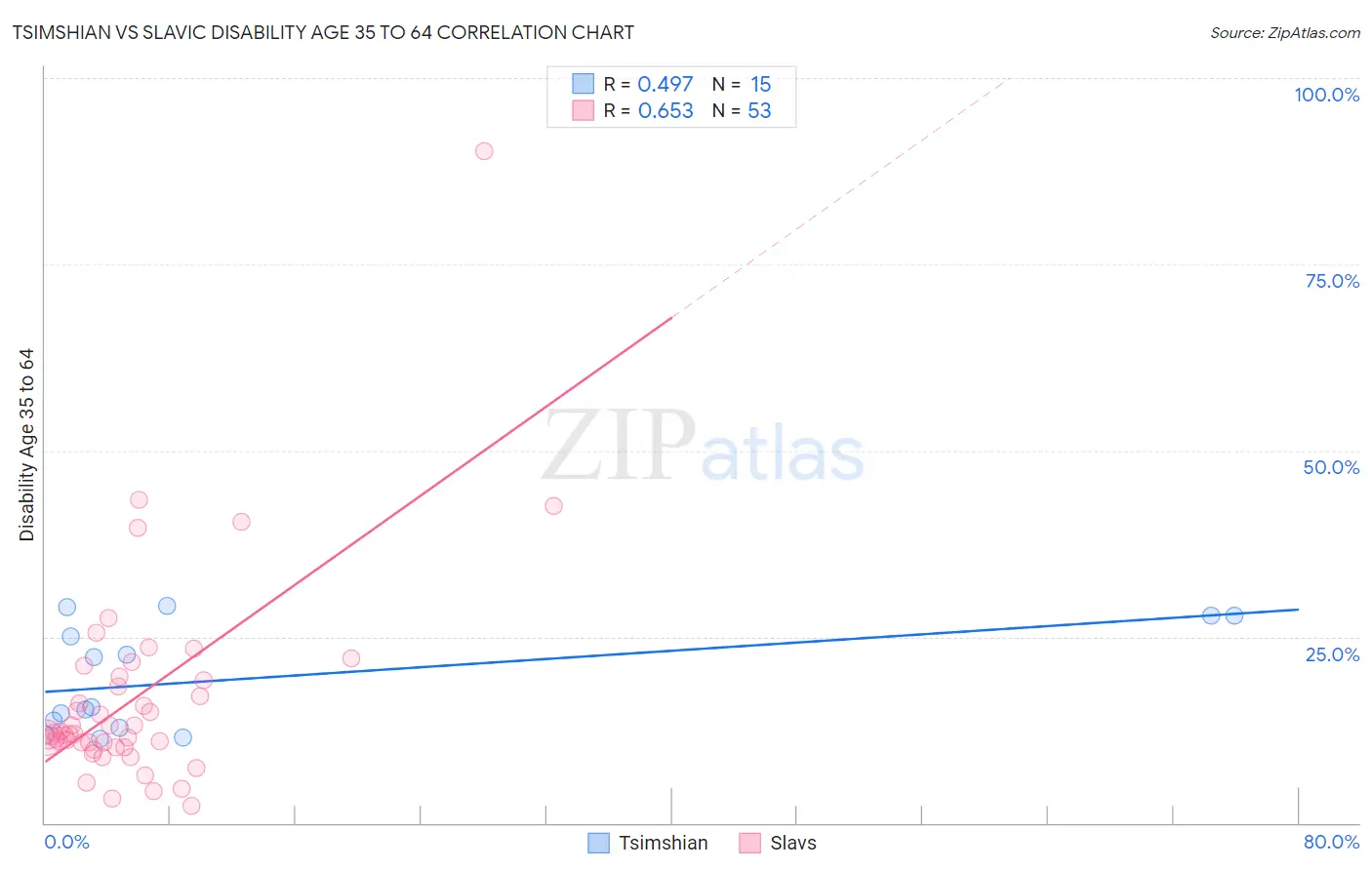Tsimshian vs Slavic Disability Age 35 to 64
COMPARE
Tsimshian
Slavic
Disability Age 35 to 64
Disability Age 35 to 64 Comparison
Tsimshian
Slavs
16.7%
DISABILITY AGE 35 TO 64
0.0/ 100
METRIC RATING
341st/ 347
METRIC RANK
11.7%
DISABILITY AGE 35 TO 64
15.5/ 100
METRIC RATING
205th/ 347
METRIC RANK
Tsimshian vs Slavic Disability Age 35 to 64 Correlation Chart
The statistical analysis conducted on geographies consisting of 15,626,462 people shows a moderate positive correlation between the proportion of Tsimshian and percentage of population with a disability between the ages 34 and 64 in the United States with a correlation coefficient (R) of 0.497 and weighted average of 16.7%. Similarly, the statistical analysis conducted on geographies consisting of 270,786,875 people shows a significant positive correlation between the proportion of Slavs and percentage of population with a disability between the ages 34 and 64 in the United States with a correlation coefficient (R) of 0.653 and weighted average of 11.7%, a difference of 43.5%.

Disability Age 35 to 64 Correlation Summary
| Measurement | Tsimshian | Slavic |
| Minimum | 11.4% | 2.3% |
| Maximum | 29.2% | 90.1% |
| Range | 17.8% | 87.9% |
| Mean | 19.4% | 16.7% |
| Median | 15.6% | 12.0% |
| Interquartile 25% (IQ1) | 12.8% | 10.5% |
| Interquartile 75% (IQ3) | 27.9% | 19.5% |
| Interquartile Range (IQR) | 15.1% | 9.0% |
| Standard Deviation (Sample) | 7.1% | 13.9% |
| Standard Deviation (Population) | 6.8% | 13.8% |
Similar Demographics by Disability Age 35 to 64
Demographics Similar to Tsimshian by Disability Age 35 to 64
In terms of disability age 35 to 64, the demographic groups most similar to Tsimshian are Tohono O'odham (16.7%, a difference of 0.11%), Creek (16.9%, a difference of 0.97%), Yup'ik (16.9%, a difference of 1.3%), Choctaw (16.4%, a difference of 1.9%), and Pima (16.1%, a difference of 3.6%).
| Demographics | Rating | Rank | Disability Age 35 to 64 |
| Yuman | 0.0 /100 | #333 | Tragic 15.8% |
| Colville | 0.0 /100 | #334 | Tragic 15.8% |
| Seminole | 0.0 /100 | #335 | Tragic 15.9% |
| Menominee | 0.0 /100 | #336 | Tragic 15.9% |
| Puerto Ricans | 0.0 /100 | #337 | Tragic 15.9% |
| Chickasaw | 0.0 /100 | #338 | Tragic 16.1% |
| Pima | 0.0 /100 | #339 | Tragic 16.1% |
| Choctaw | 0.0 /100 | #340 | Tragic 16.4% |
| Tsimshian | 0.0 /100 | #341 | Tragic 16.7% |
| Tohono O'odham | 0.0 /100 | #342 | Tragic 16.7% |
| Creek | 0.0 /100 | #343 | Tragic 16.9% |
| Yup'ik | 0.0 /100 | #344 | Tragic 16.9% |
| Kiowa | 0.0 /100 | #345 | Tragic 17.4% |
| Lumbee | 0.0 /100 | #346 | Tragic 17.6% |
| Houma | 0.0 /100 | #347 | Tragic 18.7% |
Demographics Similar to Slavs by Disability Age 35 to 64
In terms of disability age 35 to 64, the demographic groups most similar to Slavs are Native Hawaiian (11.7%, a difference of 0.10%), Ghanaian (11.7%, a difference of 0.10%), Nigerian (11.6%, a difference of 0.11%), Guatemalan (11.7%, a difference of 0.13%), and British (11.6%, a difference of 0.22%).
| Demographics | Rating | Rank | Disability Age 35 to 64 |
| Immigrants | Panama | 20.4 /100 | #198 | Fair 11.6% |
| Basques | 19.5 /100 | #199 | Poor 11.6% |
| Swiss | 18.7 /100 | #200 | Poor 11.6% |
| Immigrants | Kenya | 17.7 /100 | #201 | Poor 11.6% |
| Immigrants | Guatemala | 17.5 /100 | #202 | Poor 11.6% |
| British | 17.0 /100 | #203 | Poor 11.6% |
| Nigerians | 16.3 /100 | #204 | Poor 11.6% |
| Slavs | 15.5 /100 | #205 | Poor 11.7% |
| Native Hawaiians | 14.8 /100 | #206 | Poor 11.7% |
| Ghanaians | 14.8 /100 | #207 | Poor 11.7% |
| Guatemalans | 14.6 /100 | #208 | Poor 11.7% |
| Europeans | 13.5 /100 | #209 | Poor 11.7% |
| Belgians | 13.1 /100 | #210 | Poor 11.7% |
| Canadians | 13.0 /100 | #211 | Poor 11.7% |
| Immigrants | Jamaica | 11.8 /100 | #212 | Poor 11.7% |